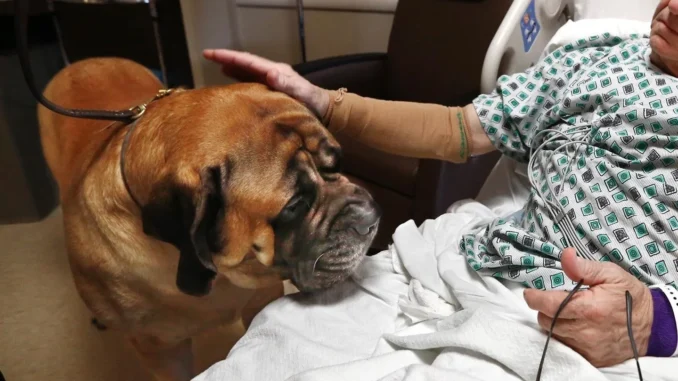
Should cats or dogs be allowed in the hospital with their dying owners…..
The question of whether cats or dogs should be allowed in hospitals with their dying owners is a deeply emotional one, touching on issues of compassion, quality of life, and the ethics of pet ownership in medical settings. Here’s a comprehensive examination of the arguments for and against allowing pets in such sensitive circumstances. The Case for Allowing Pets in Hospitals
1. Emotional Comfort and Psychological Benefits**
Pets have been shown to provide significant emotional comfort and psychological benefits to their owners. For individuals facing the end of life, the presence of a beloved pet can offer immense solace and reduce feelings of loneliness and anxiety. Studies in animal-assisted therapy have demonstrated that pets can lower blood pressure, reduce stress, and elevate mood. For a dying patient, these benefits could be particularly profound, helping them to maintain a sense of normalcy and peace.
**2. Strengthening the Human-Animal Bond**
The bond between humans and their pets is often described as deeply meaningful. Allowing pets to be with their dying owners can honor this bond, providing comfort in the final moments of life. This connection can be especially important for individuals who have lived with their pets for many years and consider them family members. The presence of a pet could make the transition smoother, giving patients a sense of continuity and connection.
**3. Enhancing the Quality of Life**
The last days of life are crucial for both the individual and their loved ones. Pets can contribute to a more positive and peaceful atmosphere, which is beneficial for the patient’s quality of life. They can also provide a source of joy and distraction from pain or discomfort, making the final days more bearable.
**4. Ethical and Compassionate Considerations**
From an ethical standpoint, allowing pets to be with their dying owners can be seen as an act of compassion. It respects the individual’s wishes and acknowledges the importance of their relationship with their pet. Hospitals have a role in providing holistic care that addresses not just physical health but emotional and psychological well-being as well.
### The Case Against Allowing Pets in Hospitals
**1. Infection Control and Health Risks**
One of the primary concerns with allowing pets in hospitals is the risk of infection. Pets can carry bacteria, viruses, or parasites that might pose a risk to patients with compromised immune systems. Hospitals have stringent infection control protocols to protect vulnerable patients, and the introduction of animals could potentially compromise these measures.
**2. Allergies and Sensitivities**
Hospitals are environments where cleanliness and patient safety are paramount. Pets could trigger allergic reactions in other patients or staff members, leading to health issues that could complicate patient care. For patients with respiratory problems or allergies, the presence of pets could exacerbate their conditions.
**3. Practical and Logistical Challenges**
Managing the presence of pets in a hospital setting presents numerous logistical challenges. Issues such as pet behavior, the need for veterinary care, and the potential for disruptions in the hospital environment need to be addressed. Ensuring that pets do not interfere with medical equipment or procedures is also a critical consideration.
**4. Emotional Impact on Other Patients and Staff**
The presence of pets could affect other patients and hospital staff. While some may find comfort in the presence of animals, others might feel distressed or uncomfortable. Balancing the needs and feelings of all individuals in a hospital setting is a complex task, and accommodating pets might lead to unintended emotional or practical challenges.
### Finding a Balanced Approach
Considering the arguments on both sides, a potential solution could involve creating specialized programs or areas within hospitals where pets can be accommodated under controlled conditions. This approach would address many of the concerns while still allowing patients to benefit from the presence of their pets.
**1. Designated Pet-Friendly Zones**
Hospitals could establish designated areas where pets are allowed, such as private rooms or specific zones designed for pet visitation. These areas could be equipped with appropriate sanitation facilities and protocols to mitigate health risks.
**2. Guidelines and Regulations**
Implementing strict guidelines for pet visitation, including health checks for pets and limits on the types of animals allowed, could help address infection control concerns. Ensuring that pets are well-behaved and do not interfere with medical procedures is also crucial.
**3. Support Services**
Hospitals could offer support services to facilitate pet visitation, such as coordination with local pet therapy organizations or volunteer programs. These services could help manage the logistics of pet visits and ensure that they are conducted safely and respectfully.
**4. Patient-Centered Care**
Ultimately, the decision to allow pets in hospitals should be guided by a patient-centered approach. Hospitals should work closely with patients and their families to understand their wishes and make accommodations where feasible. Open communication and flexibility are key to finding solutions that respect the needs and preferences of all involved.
### Conclusion
The debate over allowing cats and dogs in hospitals with their dying owners is a nuanced one, balancing emotional comfort with practical and ethical considerations. While the benefits of having a beloved pet present at the end of life are significant, so are the concerns related to infection control, allergies, and logistical challenges. Finding a balanced approach that considers the needs of patients, their families, and the broader hospital environment is essential. By exploring creative solutions and maintaining a patient-centered focus, hospitals can potentially offer compassionate and practical support for those facing the end of life.
Leave a Reply